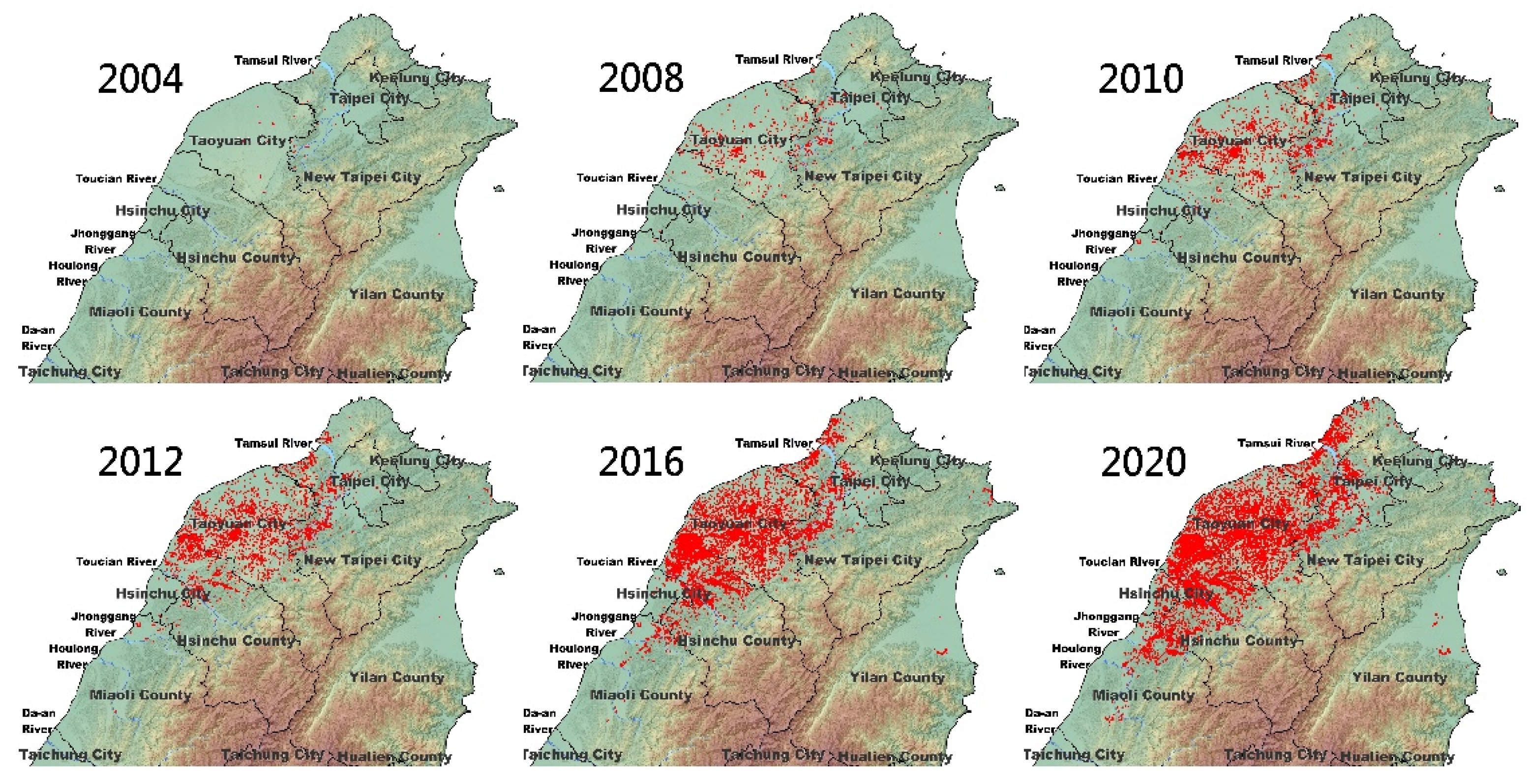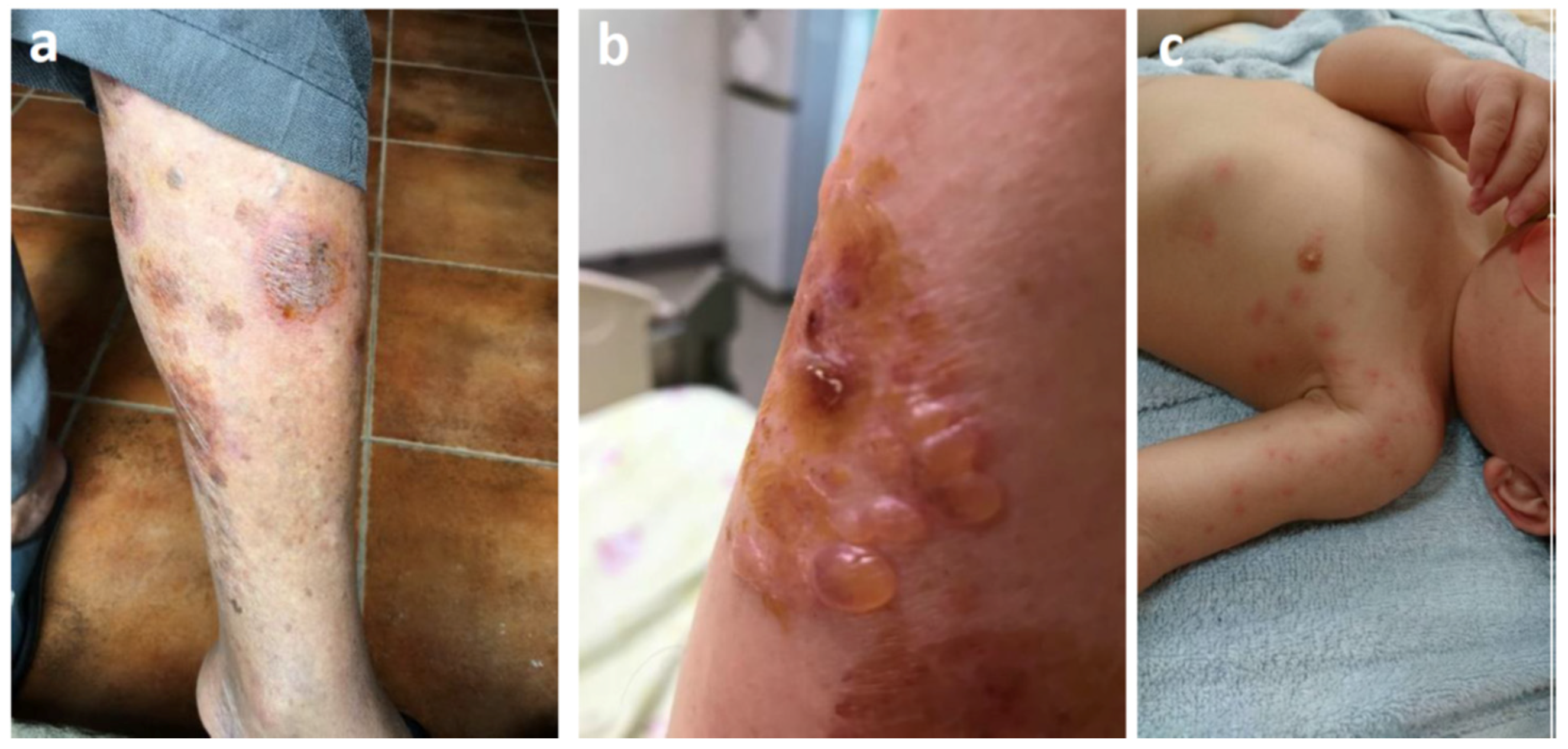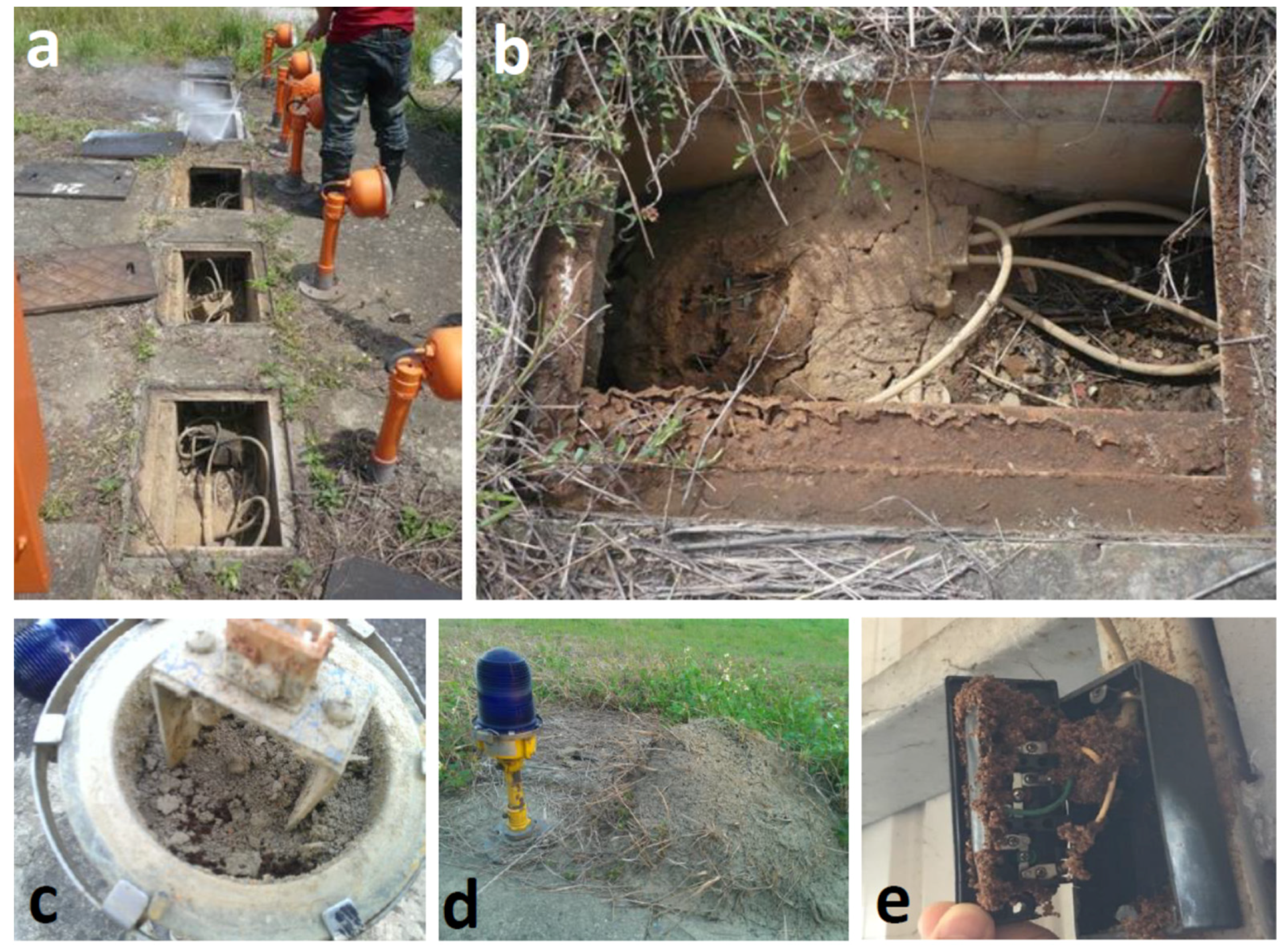Establishment and Social Impacts of the Red Imported Fire Ant, Solenopsis invicta, (Hymenoptera: Formicidae) in Taiwan
Abstract
1. Introduction
2. Materials and Methods
3. Results and Discussion
3.1. Chronological Distribution of the Red Imported Fire Ant (RIFA) in Northern Taiwan
3.2. Health Effects of RIFA on the Residents of Taiwan
3.3. Urbanization of RIFA in Taiwan
3.4. Destruction of Electrical Equipment by RIFA
3.5. Challenges of RIFA Management in Taiwan
- (1)
- RIFA is likely to have been established in Taiwan longer than previously reported. Earlier detection of an exotic organism is the general principle of biosecurity and offers a better chance of eradication. For instance, New Zealand has successfully eradicated RIFA because three incursions were detected at ports of entry very early, with only a few colonies [3]. In contrast, RIFA was thought to have arrived in 1933 in the United States but was not discovered until 1942 [42]. The cases in Taiwan, China, and Australia were similarly discovered late [41]. RIFA was likely present in Taiwan for more than five years before it was discovered in 2003 [3].
- (2)
- Highly reproductive queens can fly distances of more than 10–20 km and there are difficulties in detecting incipient infestation [20]. The nuptial flight of imported fire ants is believed to be the most successful strategy in terms of population expansion, frequently occurring in light winds of up to 5 miles/h (8.05 km/h) and temperatures between 23.8–33 °C [43]. Although 99% of the mated queens fly less than 1 mile (1.61 km) from the point of origin of their flight, there is evidence that in extreme cases, queens can fly or can be carried by the wind for 7–10 miles (11.27–16.09 km). In the United States, the most intense and extensive flights occur in May, June, and July; in Taiwan, however, they can occur throughout the year because of the warm climate and high humidity. This facilitates the rapid expansion of RIFA and renders it more difficult to manage. The current monitoring system for RIFA in Taiwan employs potato chips to attract the foraging ants [14], but it is still not easy to detect an incipient infestation. Dogs are highly sensitive agents for RIFA monitoring in areas that contain a low density of fire ant nests; however, their cost is too high and unaffordable for large-scale applications [44].
- (3)
- Movement control is difficult to achieve. Human-assisted dispersal through nursery pots and soil is the most challenging part of controlling RIFA because it can easily transport the ants over a long distance [41,45], as evidenced in the case of Taichung World Flora Exposition on 2 November 2018, in Taiwan [13]. The dilemma has to be overcome by promulgating regulations. For example, in Japan an Invasive Alien Species Act (IAS Act) was adopted in June 2004 and put into force from June 2005 with the aim of preventing the adverse effects of Invasive Alien Species (IAS) on ecosystems, human safety, agriculture, forestry or fisheries. In Taiwan, RIFA is currently governed only by the Plant Protection and Quarantine Act.
- (4)
- Manpower and the companies involved in the broadcast baits for RIFA control are insufficient, and the turnover rate is too high. The management of RIFA in Taiwan is coordinated by BAPHIQ; however, the person responsible for RIFA control is an entry-level employee in the local government or township. Unfortunately, the turnover of entry-level employees is high and it is not easy for them to become familiarized with the RIFA Control Act.
- (5)
- Meteorological conditions disfavor bait application in Taiwan. Currently, several synthetic insecticides are used as active ingredients in fire ant baits. In particular, baits with two IGR (pyriproxyfen and methoprene) are the main active ingredients for RIFA control in Taiwan. However, the phagostimulant components in the baits are quite sensitive to humidity. Taiwan is an island country with a tropical and subtropical climate, and it is often rainy in the northern part of Taiwan. According to the Central Weather Bureau of Taiwan, the number of days of precipitation in Taipei is approximately 170 days/year, which means that almost every other day is a rainy day (Table S3). These conditions make it quite challenging to broadcast bait applications for RIFA control. To operate effectively in a highly humid environment, a new fire ant bait base carrier for moist conditions was developed in 2010 [46].
- (6)
- Residents are reluctant to change their faulty concepts regarding the control of RIFA. RIFA is a social insect with the queen(s) as the only female with fully developed ovaries and responsibility for the reproductivity of the whole colony. Such insects can only be controlled by eradicating the queen(s), which usually hides inside the nest. The IGR-based bait used for RIFA control can wipe out the entire colony by destroying the queen(s) through trophallaxis. Despite repeated advocacy education programs, Taiwanese residents still treat RIFA by imitating the concepts used for the control of mosquito or other agricultural pests, which aim to kill all visible individuals with contact insecticides.
4. Conclusions
Supplementary Materials
Author Contributions
Funding
Institutional Review Board Statement
Informed Consent Statement
Data Availability Statement
Acknowledgments
Conflicts of Interest
References
- Wetterer, J.K. Exotic spread of Solenopsis invicta Buren (Hymenoptera: Formicidae) beyond North America. Sociobiology 2013, 60, 50–55. [Google Scholar] [CrossRef]
- Ascunce, M.S.; Yang, C.-C.; Oakey, J.; Calcaterra, L.; Wu, W.-J.; Shih, C.-J.; Goudet, J.; Ross, K.G.; Shoemaker, D. Global Invasion History of the Fire Ant Solenopsis invicta. Science 2011, 331, 1066–1068. [Google Scholar] [CrossRef]
- Wylie, R.; Yang, C.S.; Tsuji, K. Invader at the gate: The status of red imported fire ant in Australia and Asia. Ecol. Res. 2020, 35, 6–16. [Google Scholar] [CrossRef]
- Bertelsmeier, C. Globalization and the anthropogenic spread of invasive social insects. Curr. Opin. Insect Sci. 2021, 46, 16–23. [Google Scholar] [CrossRef] [PubMed]
- Vinson, S.B. Insect Life: Invasion of the Red Imported Fire Ant (Hymenoptera: Formicidae). Am. Èntomol. 1997, 43, 23–39. [Google Scholar] [CrossRef]
- Rhoades, R. Stinging ants. Curr. Opin. Allergy Clin. Immunol. 2001, 1, 343–348. [Google Scholar] [CrossRef] [PubMed]
- DeShazo, R.; Griffing, C.; Kwan, T.; Banks, W.; Dvorak, H. Dermal hypersensitivity reactions to imported fire ants. J. Allergy Clin. Immunol. 1984, 74, 841–847. [Google Scholar] [CrossRef]
- Tracy, J.M.; Demain, J.G.; Quinn, J.M.; Hoffman, D.R.; Goetz, D.W.; Freeman, T.M. The natural history of exposure to the imported fire ant (Solenopsis invicta). J. Allergy Clin. Immunol. 1995, 95, 824–828. [Google Scholar] [CrossRef]
- Fernández-Meléndez, S.; Miranda, A.; García-González, J.J.; Barber, D.; Lombardero, M. Anaphylaxis caused by imported red fire ant stings in Málaga, Spain. J. Investig. Allergol. Clin. Immunol. 2007, 17, 48–49. [Google Scholar]
- More, D.R.; Kohlmeier, R.E.; Hoffman, D.R. Fatal Anaphylaxis to Indoor Native Fire Ant Stings in an Infant. Am. J. Forensic Med. Pathol. 2008, 29, 62–63. [Google Scholar] [CrossRef]
- Solley, G.; VanDerWoude, C.; Knight, G.K. Anaphylaxis due to Red Imported Fire Ant sting. Med J. Aust. 2002, 176, 521–523. [Google Scholar] [CrossRef]
- Yeh, Y. Current status and development of plant pest information management system in Taiwan. In Extension Bulletins, Food and Fertilizer Technology Center; Asian and Pacific Region: Taipei, Taiwan, 2006; Volume EB582. [Google Scholar]
- Liu, H.; Lin, C.C.; Huang, L.H.; Huang, S.A.; Huang, R.N. Eradication and control strategies of red imported fire ants (Solenopsis invicta) in Taiwan: Lessons from three case studies. Sustainability 2020, 12, 3951. [Google Scholar] [CrossRef]
- Bao, S.Z.; Kafle, L.; Shih, C.J. A new baited trap for monitoring Solenopsis invicta (Formicidae: Hymenoptera) in Taiwan. Appl. Èntomol. Zoöl. 2011, 46, 165–169. [Google Scholar] [CrossRef]
- Huang, T.C.; Chou, Y.C.; Chou, H.C. The infestation and control of the red imported fire ants in Taiwan, Symposium of Control Red Imported Fire Ant; Shih, C.J., Wu, W.J., Eds.; Bureau of Animal and Plant Health Inspection and Quarantine; Council of Agriculture, Executive Yuan: Taipei, Taiwan, 2004; pp. 1–13.
- Banks, W.A.; Weidhaas, D.E.; Glancey, B.M.; Stringer, C.E.; Jouvenaz, D.P.; Lofgren, C.S. Imported Fire Ants: Eradication Trials with Mirex Bait12. J. Econ. Èntomol. 1973, 66, 785–789. [Google Scholar] [CrossRef]
- Wojcik, D.P. Comparison of the Ecology of Red Imported Fire Ants in North and South America. Fla. Èntomol. 1983, 66, 101. [Google Scholar] [CrossRef]
- Vogt, J.T.; Appel, A.G.; West, M.S. Flight energetics and dispersal capability of the fire ant, Solenopsis invicta Buren. J. Insect Physiol. 2000, 46, 697–707. [Google Scholar] [CrossRef]
- Scanlan, J.C.; VanDerWoude, C. Modelling the potential spread of Solenopsis invicta Buren (Hymenoptera: Formicidae) (red imported fire ant) in Australia. Aust. J. Èntomol. 2006, 45, 1–9. [Google Scholar] [CrossRef]
- Kemp, S.F.; DeShazo, R.D.; Moffitt, J.E.; Williams, D.F.; Buhner, W.A. Expanding habitat of the imported fire ant (Solenopsis invicta): A public health concern. J. Allergy Clin. Immunol. 2000, 105, 683–691. [Google Scholar] [CrossRef]
- MacConnell, J.; Blum, M.; Fales, H. The chemistry of fire ant venom. Tetrahedron 1971, 27, 1129–1139. [Google Scholar] [CrossRef]
- Stafford, C.T.; Hutto, L.S.; Rhoades, R.B.; Thompson, W.O.; Impson, L.K. Imported Fire Ant as a Health Hazard. South. Med J. 1989, 82, 1515–1519. [Google Scholar] [CrossRef]
- Prahlow, J.A.; Barnard, J.J. Fatal Anaphylaxis Due to Fire Ant Stings. Am. J. Forensic Med. Pathol. 1998, 19, 137–142. [Google Scholar] [CrossRef] [PubMed]
- Taber, S.W. Fire Ants. College Station; Texas A&M University Press: College Station, TX, USA, 2000; pp. 1–308. [Google Scholar]
- Dress, B.M. Medical Problems and Treatment Considerations for the Red Imported Fire Ant; College Station; Texas A & M Agrilife Extension: College Station, TX, USA, 2002. [Google Scholar]
- DeShazo, R.D.; Williams, D.F.; Moak, E.S. Fire ant attacks on residents in health care facilities: A report of two cases. Ann. Intern. Med. 1999, 131, 424–429. [Google Scholar] [CrossRef]
- Zhang, R.; Li, Y.; Liu, N.; Porter, S.D. An Overview of the Red Imported Fire Ant (Hymenoptera: Formicidae) in Mainland China. Fla. Èntomol. 2007, 90, 723–731. [Google Scholar] [CrossRef]
- Clemmer, D.I.; Serfling, R.E. The Imported Fire Ant. South. Med J. 1975, 68, 1133–1138. [Google Scholar] [CrossRef]
- Caldwell, S.T.; Schuman, S.H.; Simpson, W.M. Fire ants: A continuing community health threat in South Carolina. J. South Carol. Med Assoc. 1999, 95, 29. [Google Scholar]
- Williams, D.F.; Collins, H.L.; Oi, D.H. The Red Imported Fire Ant (Hymenoptera: Formicidae): An Historical Perspective of Treatment Programs and the Development of Chemical Baits for Control. Am. Èntomol. 2001, 47, 146–159. [Google Scholar] [CrossRef]
- Lard, C.; Willis, D.B.; Salin, V.; Robinson, S. Economic assessments of red imported fire ant in Texas’ urban and agricultural sectors. Southwest. Entomol. 2002, 25, 123–137. [Google Scholar]
- Chang, F.C. Analysis of the Benefit of Red Imported Fire Ant Controlling Policy on Household and Agricultural Sectors in Toyuan County; National Chung Hsing University: Taichung, Taiwan, 2006. [Google Scholar]
- Central News Agency. Athletes’ Village Opens Its Doors to Taipei Universiade Participants. Taiwan News 2017. Available online: https://www.taiwannews.com.tw/en/news/3231427 (accessed on 20 April 2020).
- Ritchie, H.; Roser, M. Urbanization. Available online: https://ourworldindata.org/urbanization (accessed on 20 April 2020).
- Güneralp, B.; Zhou, Y.; Ürge-Vorsatz, D.; Gupta, M.; Yu, S.; Patel, P.L.; Fragkias, M.; Li, X.; Seto, K.C. Global scenarios of urban density and its impacts on building energy use through 2050. Proc. Natl. Acad. Sci. USA 2017, 114, 8945–8950. [Google Scholar] [CrossRef] [PubMed]
- Slowik, T.J. Response of the Red Imported Fire Ant (Solenopsis invicta Buren) to Electricity and Magetism; Texas Tech University: Lubbock, TX, USA, 1995. [Google Scholar]
- Drees, B.M. Managing Red Imported Fire Ant in Electrical Equipment and Utility Housings; Texas Imported Fire Ant Re-search & Management Project; Texas A&M University System: College Station, TX, USA, 1998; p. 4. [Google Scholar]
- Dress, B.M.; Nester, P.; Brown, W.; Keck, M.; Flanders, K. Fire Ant Control: The Two-Step Method and Other Approach; College Station; Texas A & M Agrilife Extension: College Station, TX, USA, 2021. [Google Scholar]
- Lowe, S.; Browne, M.; Boudjelas, S.; De Poorter, M. 100 of the World’s Worst Invasive Alien Species: A Selection from The Global Invasive Species Database; Invasive Species Specialist Group: Auckland, New Zealand, 2000. [Google Scholar]
- Wylie, F.R.; Janssen-May, S. Red Imported Fire Ant in Australia: What if we lose the war? Ecol. Manag. Restor. 2016, 18, 32–44. [Google Scholar] [CrossRef]
- Wang, L.; Zeng, L.; Xuv, Y.; Lu, Y. Prevalence and management of Solenopsis invicta in China. NeoBiota 2020, 54, 89–124. [Google Scholar] [CrossRef]
- Tschinkel, W.R. The Fire Ants; Belknap Press: Cambridge, UK, 2013. [Google Scholar]
- Markin, G.P.; Dillier, J.H.; Hill, S.O.; Blum, M.S.; Hermann, H.R. Nuptial flight and flight ranges of the imported fire ant, Solenopsis saevissima richteri (Hymenoptera: Formicidae). J. Ga. Entomol. Soc. 1971, 6, 145–156. [Google Scholar]
- Lin, H.-M.; Chi, W.-L.; Lin, C.-C.; Tseng, Y.-C.; Chen, W.-T.; Kung, Y.-L.; Lien, Y.-Y.; Chen, Y.-Y. Fire ant-detecting canines: A complementary method in detecting red imported fire ants. J. Econ. Èntomol. 2011, 104, 225–231. [Google Scholar] [CrossRef] [PubMed]
- Rayment, G. Australian Efforts to Prevent the Accidental Movement of Pests and Diseases in Soil and Plant Samples. Commun. Soil Sci. Plant Anal. 2006, 37, 2107–2117. [Google Scholar] [CrossRef]
- Kafle, L.; Wu, W.-J.; Shih, C.-J. A new fire ant (Hymenoptera: Formicidae) bait base carrier for moist conditions. Pest Manag. Sci. 2010, 66, 1082–1088. [Google Scholar] [CrossRef]




| Seeking Medical Care (Percentage) | ||||||
|---|---|---|---|---|---|---|
| Characteristics | Total Record (%) | No (%) | Yes (%) | |||
| Wheal-and-flare reaction | ||||||
| No | 3017 | (79.0%) | 2835 | (94.0%) | 182 | (6.00%) |
| Yes | 802 | (21.0%) | 696 | (86.8%) | 106 | (13.2%) |
| Anaphylactic shock | ||||||
| No | 3713 | (97.2%) | 3495 | (94.1%) | 218 | (5.90%) |
| Yes | 106 | (2.8%) | 36 | (34.0%) | 70 | (66.0%) |
| Cellulitis or Urticaria | ||||||
| No | 3798 | (99.5%) | 3510 | (62.40%) | 288 | (37.6%) |
| Yes | 21 | (0.50%) | 21 | (100.0%) | 0 | (0.00%) |
| Number of People Stung by RIFA | 3819 | 3531 | (92.5%) | 288 | (7.50%) | |
Publisher’s Note: MDPI stays neutral with regard to jurisdictional claims in published maps and institutional affiliations. |
© 2021 by the authors. Licensee MDPI, Basel, Switzerland. This article is an open access article distributed under the terms and conditions of the Creative Commons Attribution (CC BY) license (https://creativecommons.org/licenses/by/4.0/).
Share and Cite
Liu, Y.-S.; Huang, S.-A.; Lin, I.-L.; Lin, C.-C.; Lai, H.-K.; Yang, C.-H.; Huang, R.-N. Establishment and Social Impacts of the Red Imported Fire Ant, Solenopsis invicta, (Hymenoptera: Formicidae) in Taiwan. Int. J. Environ. Res. Public Health 2021, 18, 5055. https://doi.org/10.3390/ijerph18105055
Liu Y-S, Huang S-A, Lin I-L, Lin C-C, Lai H-K, Yang C-H, Huang R-N. Establishment and Social Impacts of the Red Imported Fire Ant, Solenopsis invicta, (Hymenoptera: Formicidae) in Taiwan. International Journal of Environmental Research and Public Health. 2021; 18(10):5055. https://doi.org/10.3390/ijerph18105055
Chicago/Turabian StyleLiu, Yu-Sheng, Sin-An Huang, I-Lin Lin, Chung-Chi Lin, Hung-Kuan Lai, Chun-Hsiang Yang, and Rong-Nan Huang. 2021. "Establishment and Social Impacts of the Red Imported Fire Ant, Solenopsis invicta, (Hymenoptera: Formicidae) in Taiwan" International Journal of Environmental Research and Public Health 18, no. 10: 5055. https://doi.org/10.3390/ijerph18105055
APA StyleLiu, Y.-S., Huang, S.-A., Lin, I.-L., Lin, C.-C., Lai, H.-K., Yang, C.-H., & Huang, R.-N. (2021). Establishment and Social Impacts of the Red Imported Fire Ant, Solenopsis invicta, (Hymenoptera: Formicidae) in Taiwan. International Journal of Environmental Research and Public Health, 18(10), 5055. https://doi.org/10.3390/ijerph18105055






